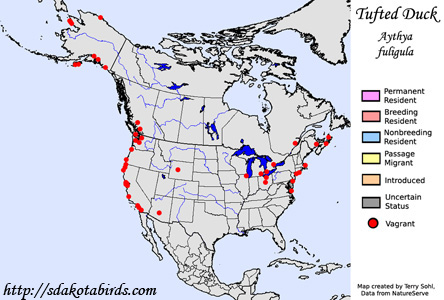Tufted Duck
Aythya fuligula
| Length: 17 inches | Wingspan: 26 inches | Seasonality: Non-resident in South Dakota |
| ID Keys: Males with obvious long tuft at back of head, otherwise breeding adult males are dark with white flanks and belly. Females similar in structure but brown overall, grayish-brown flanks and belly. | ||
 The
Tufted Duck is a common diving duck of the Eastern Hemisphere, living
throughout much of Eurasia. They are winter vagrants in North America,
where they are most often found in Alaska, but they can also occasionally be
found along northern parts of both the Pacific and Atlantic Coasts of North
America. They are often considered the Old World's ecological equivalent to
North America's Ring-necked Duck, to
which they are closely related.
The
Tufted Duck is a common diving duck of the Eastern Hemisphere, living
throughout much of Eurasia. They are winter vagrants in North America,
where they are most often found in Alaska, but they can also occasionally be
found along northern parts of both the Pacific and Atlantic Coasts of North
America. They are often considered the Old World's ecological equivalent to
North America's Ring-necked Duck, to
which they are closely related.
Habitat: During the summer breeding season, Tufted Ducks are found in and around shallow water, freshwater lakes and ponds, typically those with significant herbaceous vegetation around them margins. They often prefer to nest on islands in these habitats. They can be found in a wider variety of aquatic habitats in migration and in their winter range.
Diet: Tufted Ducks will feed on a variety of items, including clams and other mollusks, snails, aquatic insects and their larvae, roots, tubers, and other parts of aquatic vegetation, and occasionally small fish. On their winter range, they will also utilize waste grain in agricultural fields.
Nesting: The nest of a Tufted Duck consists of vegetation, either on the shoreline of islands, vegetation along the shoreline of a lake, or on floating mats of vegetation.
Behavior: Strong swimmers, most of the foraging is done by diving and swimming underwater. They will also sometimes behave like dabbling ducks.
Song: The male has a fast whistled hooting when courting females. Females have a soft growing.
Migration: The Tufted Duck breeds in much of the northern portion of Europe and Asia. They migrate to more temperate locations in Europe and Asia for the winter.
Interactive eBird Map: Click here to access an interactive eBird map of Tufted Duck sightings
Similar Species: Trumpeter Swan, Tundra Swan, Mute Swan
Conservation Status: There are no major threats to populations of the Tufted Duck and the IUCN currently lists it as a species of "Least Concern".
Further Information: 1) Audubon Field Guide - Tufted Duck
2) Wikipedia - Tufted Duck
3) WhatBird - Tufted Duck
Photo Information: Photo taken on January 5th, 2010 - West Bromwich, England - Photo by Tony Hisgett - Photo licensed under Creative Commons Attribution 2.0 Generic License.
| Click below for a higher-resolution map |
 |
| South Dakota Status: Non-resident in South Dakota |
Additional Tufted Duck Photos (coming soon!!)
